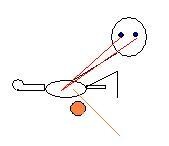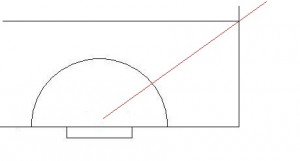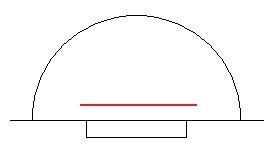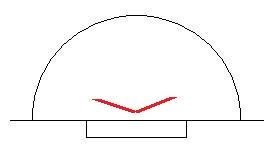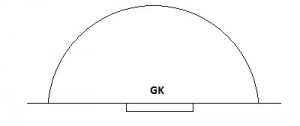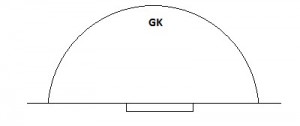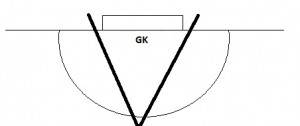With the ever improving production of developed right hand protectors (rhp’s) with an increased blocking surface and better rebound properties, the modern goalkeeper has a better chance of making saves to their right hand side. Without the need to bring the left hand glove across, the goalkeeper can make use of their rhp to block shots. With a larger surface to block the ball than the shaft of a stick, you should look to actively make a strong technique of saving to the right side appropriately on raised shots and flicks.
Why use the rhp?
Making use of the rhp is done for obvious reasons. With an increased surface area than the stick to block with, you can actively turn the rhp to turn away the ball to safety, whilst making the save. Also, when trying to make a save with the glove on the right hand side, you can end up over rotating as you turn to reach the ball; effectively taking yourself out of the play as you turn too far. By learning to make saves with the rhp instead, you increase your chances of making the save, as you turn in to face the ball, as well as making it easier to control rebounds. It is possible to make saves like this with a tubular style glove, but there are more, larger surface area rhp’s out there for goalkeepers to utilise. Making independent saves like this means you are not in danger of over rotating and makes you harder to beat!
Eye contact and focus
Just like any save, you need to be focused on the specific piece of kit you will be making the stop with. As much as you concentrate on your glove for a save there, you need to be just as intensely focused on the shot going to your right. Rather than focusing on the stick, you need to focus your attention on the larger blocking area of the rhp. As the ball comes in, this sustained eye contact will make it easier to see the flight of the ball into the rhp and away to safety.
Attacking the ball
As discussed before, attacking the ball helps cut down the time the ball takes to reach you, and helps with a forceful push away on the save. Having your arms forward so your gloves are upright and facing the shot makes it easier to move into the save. By pushing into the save, from a 30 degree angle, rather than passively reacting helps with you when turning the glove to control the rebound. If the ball is high, then you will be looking to push up, whilst if it is to the side of your body, then you are obviously going to be looking to push out to the side in extension to block the ball.
Turning the rhp
Turning the rhp allows you to push the ball away to control the rebound, like you would when stopping shots with your glove to the left. The angle would almost be about 70 degrees, but you also want to turn at the wrist, so it blocks to the side, rather than simply blocking to the front. Rather than the ball simply bounce off your glove and down, into a dangerous area for a secondary chance at goal, turning it away on the shot, to safety, effectively kills any rebound opportunities. You need to aim to push into the block, turning at the elbow and wrist, for the redirect. If it is to the side of you, you can turn the ball away wide. It is possible to redirect a high shot over the ball, although this takes practise and a second sense of where the goal and crossbar is!
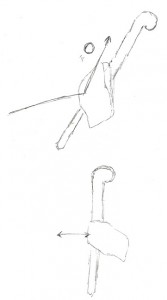
As the crudely drawn diagram illustrates,
an angled rhp gives greater redirection
on an upright shot, for rebound control.
T
Saving low
When making low saves, it is also possible to turn the ball away with the rhp as you stop the ball. When diving low (as well as high), in extension, or diving at around knee height on drag flicks off the floor, employing the same technique will help control rebounds.
Stick inclusion
In case you miss the ball, the stick is a back-up option. Your focus should be on making the stop with the rhp, so should not over rely on the stick. Whilst you should prioritise making saves to the right of your body, the option is there to save your blushes if needs be. The technique remains the same; focusing on the ball and turning at the wrist as you move to block.
Decisiveness with the save
Confusion over which glove to use can obviously cause problems when aiming to stop the ball to the right, which is another reason you should practise saving solely with the rhp. By crossing gloves and being indecisive, it is obviously harder to make the save. Instead, by restricting yourself to using the appropriate glove for the appropriate side, you will be better suited to making the save.
Active with right hand saves
Ultimately, you want to be just as strong and active with your saves to the right as you are with those to your left. Improving technique and getting more proactive with blocking to the right will help you against shots high to the right, being able to make a controlled and active save with your rhp. The more you enforce this in training and in games, the better you will get at having an active rhp.
Pointers:
- Actively push into the save and attack the ball
- Focus on the ball and rhp to exercise concentration
- Turn the rhp into the save, to help redirect the ball away to safety
- Don’t over rotate or cross over with the glove, making sure you choose the rhp rather than glove for the save
